Assessing the Feasibility of a Cloud-Based, Spatially Distributed Modeling Approach for Tracking Green Stormwater Infrastructure Runoff Reductions
Abstract
:1. Introduction
2. Methods and Data
2.1. Model Scales of Representation
2.2. Rainfall Calculations
2.3. Rainfall–Runoff Transformation
2.4. Runoff Reduction Accounting
2.5. Model Structure and User Interface
2.6. Input Data
2.7. Study Catchments
2.8. Comparison with the Catchment-Scale swTELR
2.9. Monitoring Data and Model Comparisons
3. Results
3.1. Comparison with the Catchment-Scale swTELR
3.2. Flow Monitoring Data
3.3. Runoff Estimates and Model Evaluation
3.4. GSI Benefits Tracking
4. Discussion
4.1. Model Baseline Performance
4.2. Application to GSI Tracking
5. Conclusions
6. Patents
Author Contributions
Funding
Institutional Review Board Statement
Informed Consent Statement
Data Availability Statement
Acknowledgments
Conflicts of Interest
References
- Booth, D.B.; Jackson, C.R. Urbanization of aquatic systems: Degradation thresholds, stormwater detection, and the limits of mitigation. JAWRA J. Am. Water Resour. Assoc. 1997, 33, 1077–1090. [Google Scholar] [CrossRef]
- Tang, Z.; Engel, B.; Pijanowski, B.; Lim, K. Forecasting land use change and its environmental impact at a watershed scale. J. Environ. Manag. 2005, 76, 35–45. [Google Scholar] [CrossRef] [PubMed]
- US EPA (Environmental Protection Agency). Our Built and Natural Environments: A Technical Review of the Interactions between Land Use, Transportation, and Environmental Quality, 2nd ed.; EPA 231-K-13-001; US EPA: Washington, DC, USA, 2013.
- Pennino, M.J.; McDonald, R.I.; Jaffe, P.R. Watershed-scale impacts of stormwater green infrastructure on hydrology, nutrient fluxes, and combined sewer overflows in the mid-Atlantic region. Sci. Total Environ. 2016, 565, 1044–1053. [Google Scholar] [CrossRef] [PubMed] [Green Version]
- Davis, A.P. Field Performance of Bioretention: Water Quality. Environ. Eng. Sci. 2007, 24, 1048–1064. [Google Scholar] [CrossRef]
- Venkataramanan, V.; Lopez, D.; McCuskey, D.J.; Kiefus, D.; McDonald, R.I.; Miller, W.M.; Packman, A.I.; Young, S.L. Knowledge, attitudes, intentions, and behavior related to green infrastructure for flood management: A systematic literature review. Sci. Total Environ. 2020, 720, 137606. [Google Scholar] [CrossRef]
- Tao, J.; Li, Z.; Peng, X.; Ying, G. Quantitative analysis of impact of green stormwater infrastructures on combined sewer overflow control and urban flooding control. Front. Environ. Sci. Eng. 2017, 11, 11. [Google Scholar] [CrossRef]
- Zellner, M.L.; Massey, D.; Minor, E.; Gonzàlez-Meler, M.A. Exploring the effects of green infrastructure placement on neighborhood-level flooding via spatially explicit simulations. Comput. Environ. Urban. Syst. 2016, 59, 116–128. [Google Scholar] [CrossRef] [Green Version]
- Dussaillant, A.R.; Cuevas, A.; Potter, K.W. Raingardens for stormwater infiltration and focused groundwater re-charge: Simulations for different world climates. Water Sci. Technol. Water Supply 2005, 5, 173–179. [Google Scholar] [CrossRef]
- Bhaskar, A.S.; Hogan, D.M.; Nimmo, J.R.; Perkins, K.S. Groundwater recharge amidst focused stormwater infiltration. Hydrol. Process. 2018, 32, 2058–2068. [Google Scholar] [CrossRef]
- Chen, W.Y. The role of urban green infrastructure in offsetting carbon emissions in 35 major Chinese cities: A nationwide estimate. Cities 2015, 44, 112–120. [Google Scholar] [CrossRef]
- Foster, J.; Lowe, A.; Winkelman, S. The value of green infrastructure for urban climate adaptation. Cent. Clean Air Policy 2011, 750, 1–52. [Google Scholar]
- Gill, S.E.; Handley, J.F.; Ennos, A.R.; Pauleit, S. Adapting cities for climate change: The role of the green infra-structure. Built Environ. 2007, 33, 115–133. [Google Scholar] [CrossRef] [Green Version]
- Clary, J.; Urbonas, B.; Jones, J.; Strecker, E.; Quigley, M.; O’Brien, J. Developing, evaluating and maintaining a standardized stormwater BMP effectiveness database. Water Sci. Technol. 2002, 45, 65–73. [Google Scholar] [CrossRef] [PubMed]
- Strecker, E.W.; Quigley, M.M.; Urbonas, B.; Jones, J. Analyses of the Expanded EPA/ASCE International BMP Database and Potential Implications for BMP Design. Crit. Transit. Water Environ. Resour. Manag. 2004, 1–10. [Google Scholar] [CrossRef]
- Ackerman, D.; Stein, E.D. Evaluating the Effectiveness of Best Management Practices Using Dynamic Modeling. J. Environ. Eng. 2008, 134, 628–639. [Google Scholar] [CrossRef]
- Jarden, K.M.; Jefferson, A.J.; Grieser, J.M. Assessing the effects of catchment-scale urban green infrastructure retrofits on hydrograph characteristics. Hydrol. Process. 2016, 30, 1536–1550. [Google Scholar] [CrossRef]
- Golden, H.E.; Hoghooghi, N. Green infrastructure and its catchment-scale effects: An emerging science. Wiley Interdiscip. Rev. Water 2018, 5, e1254. [Google Scholar] [CrossRef] [PubMed] [Green Version]
- Ahiablame, L.M.; Engel, B.A.; Chaubey, I. Effectiveness of low impact development practices in two urbanized water-sheds: Retrofitting with rain barrel/cistern and porous pavement. J. Environ. Manag. 2013, 119, 151–161. [Google Scholar] [CrossRef]
- Loperfido, J.; Noe, G.B.; Jarnagin, S.T.; Hogan, D.M. Effects of distributed and centralized stormwater best management practices and land cover on urban stream hydrology at the catchment scale. J. Hydrol. 2014, 519, 2584–2595. [Google Scholar] [CrossRef]
- Kong, F.; Ban, Y.; Yin, H.; James, P.; Dronova, I. Modeling stormwater management at the city district level in response to changes in land use and low impact development. Environ. Model. Softw. 2017, 95, 132–142. [Google Scholar] [CrossRef]
- Avellaneda, P.M.; Jefferson, A.J.; Grieser, J.M.; Bush, S.A. Simulation of the cumulative hydrological response to green infrastructure. Water Resour Res. 2017, 53, 3087–3101. [Google Scholar] [CrossRef]
- Vogel, J.R.; Moore, T.L.; Coffman, R.R.; Rodie, S.N.; Hutchinson, S.L.; McDonough, K.R.; McLemore, A.J.; McMaine, J.T. Critical Review of Technical Questions Facing Low Impact Development and Green Infrastructure: A Perspective from the Great Plains. Water Environ. Res. 2015, 87, 849–862. [Google Scholar] [CrossRef] [PubMed]
- Sarkar, S.; Butcher, J.B.; Johnson, T.E.; Clark, C.M. Simulated Sensitivity of Urban Green Infrastructure Practices to Climate Change. Earth Interact. 2018, 22, 1–37. [Google Scholar] [CrossRef] [PubMed]
- Roy, A.H.; Rhea, L.K.; Mayer, A.L.; Shuster, W.D.; Beaulieu, J.J.; Hopton, M.E.; Morrison, M.A.; Amand, A.S. How Much Is Enough? Minimal Responses of Water Quality and Stream Biota to Partial Retrofit Stormwater Management in a Suburban Neighborhood. PLoS ONE 2014, 9, e85011. [Google Scholar] [CrossRef] [PubMed]
- California State Water Resources Control Board (CA SWRCB). Municipal Regional Stormwater Permit for the San Francisco Bay Region; Order Number R2-2015-0049; San Francisco Bay Regional Water Quality Control Board: Oakland, CA, USA, 2015; p. 359.
- Petrucci, G.C.; Bonhomme, R. The dilemma of spatial representation for urban hydrology semi-distributed modelling: Trade-offs among complexity, calibration, and geographical data. J. Hydrol. 2014, 517, 997–1007. [Google Scholar] [CrossRef]
- Yuan, L.; Sinshaw, T.; Forshay, K.J. Review of Watershed-Scale Water Quality and Nonpoint Source Pollution Models. Geosciences 2020, 10, 25. [Google Scholar] [CrossRef] [Green Version]
- Kokkonen, T.S.; Jakeman, A.J. A comparison of metric and conceptual approaches in rainfall-runoff modeling and its implications. Water Resour. Res. 2001, 37, 2345–2352. [Google Scholar] [CrossRef] [Green Version]
- Dotto, C.B.S.; Kleidorfer, M.; Deletic, A.; Rauch, W.; McCarthy, D.; Fletcher, T. Performance and sensitivity analysis of stormwater models using a Bayesian approach and long-term high resolution data. Environ. Model. Softw. 2011, 26, 1225–1239. [Google Scholar] [CrossRef]
- Beck, N.G.; Conley, G.; Kanner, L.; Mathias, M. An urban runoff model designed to inform stormwater management decisions. J. Environ. Manag. 2017, 193, 257–269. [Google Scholar] [CrossRef]
- Jayasooriya, V.M.; Ng, A.W.M. Tools for modeling of stormwater management and economics of green infra-structure practices: A review. WaterAirSoil Pollut. 2014, 225, 2055. [Google Scholar] [CrossRef] [Green Version]
- USDA-NRCS (U.S. Department of Agriculture-Natural Resources Conservation Service). Urban Hydrology for Small Watersheds, 2nd ed.; Technical Release 55; NTIS PB87-101580; USDA NRCS: Springfield, VA, USA, 1986.
- Woodward, D.E.; Hawkins, R.H.; Jiang, R.; Hjelmfelt, A.T., Jr.; Van Mullem, J.A.; Quan, Q.D. Runoff curve number method: Examination of the initial abstraction ratio. World Water Environ. Resour. Congr. 2003, 1, e10. [Google Scholar] [CrossRef] [Green Version]
- Lim, K.J.; Engel, B.; Muthukrishnan, S.; Harbor, J.; Harbor, J. Effects of initial abstraction and urbanization on estimated runoff using Cn technology. JAWRA J. Am. Water Resour. Assoc. 2006, 42, 629–643. [Google Scholar] [CrossRef]
- Michel, C.; Andréassian, V.; Perrin, C. Soil Conservation Service Curve Number method: How to mend a wrong soil moisture accounting procedure? Water Resour. Res. 2005, 41, 17. [Google Scholar] [CrossRef]
- Jiang, R. Investigation of Runoff Curve Number Initial Abstraction Ratio. Master’s Thesis, University of Arizona, Tucson, AZ, USA, 2001. Available online: http://arizona.openrepository.com/arizona/handle/10150/191301 (accessed on 10 September 2015).
- Hawkins, R.H.; Jiang, R.; Woodward, D.E.; Hjelmfelt, A.T.; Van Mullem, J.A. Runoff Curve Number Method: Examination of the Initial Abstraction Ratio. In Proceedings of the Second Federal Interagency Hydrologic Modeling Conference, Las Vegas, NV, USA, 28 July–1 August 2002; U.S. Geological Survey: Lakewood, CO, USA. [Google Scholar]
- PRISM Climate Group. Oregon State University. Available online: http://prism.oregonstate.edu (accessed on 4 February 2004).
- R Core Team. R: A Language and Environment for Statistical Computing; R Foundation for Statistical Computing: Vienna, Austria, 2018; Available online: https://www.R-project.org/ (accessed on 10 November 2020).
- Hijmans, R.J. Raster: Geographic Data Analysis and Modeling. Available online: https://CRAN.R-project.org/package=raster (accessed on 15 August 2017).
- National Land Cover Database (NLCD). Urban Imperviousness, Updated 2016. Available online: https://www.mrlc.gov/ (accessed on 1 October 2017).
- Manning, R.; Griffith, J.P.; Pigot, T.F.; Vernon-Harcourt, L.F. On the flow of water in open channels and pipes. Trans. Inst. Civ. Eng. Irel. 1890, 20, 161–207. [Google Scholar]
- California State Water Resources Control Board (CCRWQCB). Stormwater Discharges from Small Municipal Separate Storm Sewer Systems; Water Quality Order No. 2013-0001-DWQ; General Permit No. CAS000004; California State Water Resources Control Board: Oakland, CA, USA, 2013.
- Schaefli, B.; Gupta, H.V. Do Nash values have value? Hydrol. Process. 2007, 21, e2075–e2080. [Google Scholar] [CrossRef] [Green Version]
- Brezonik, P.L.; Stadelmann, T.H. Analysis and predictive models of stormwater runoff volumes, loads, and pollutant concentrations from watersheds in the Twin Cities metropolitan area, Minnesota, USA. Water Res. 2002, 36, 1743–1757. [Google Scholar] [CrossRef]
- Leavesly, G.H.; Lichty, R.W.; Troutman, B.M.; Saindon, L.G. Precipitaion and Runoff Modelling System—User’s Manual; USGS Water Resources Investigation Report 83—4238; US Department of the Interior: Washington, DC, USA, 1983.
- Beven, K.J. Prophecy, reality and uncertainty in distributed hydrological modelling. Adv. Water Resour. 1993, 16, 41–51. [Google Scholar] [CrossRef]
- Beven, K. A manifesto for the equifinality thesis. J. Hydrol. 2006, 320, 18–36. [Google Scholar] [CrossRef] [Green Version]
- San Mateo County Water Pollution Prevention Program (SMCWPPP). Phase I Baseline Modeling Report—Provides Documentation of the Development, Calibration, and Validation of the Baseline Hydrology and Water Quality Model, and the Determination of PCB and Mercury Load Reductions to be Addressed through GI Implementation; Final Report; San Mateo Countywide Pollution Prevention Program: Redwood City, CA, USA, 2018; p. 169.
- Bertrand-Krajewski, J.-L. Stormwater pollutant loads modelling: Epistemological aspects and case studies on the influence of field data sets on calibration and verification. Water Sci. Technol. 2007, 55, 1–17. [Google Scholar] [CrossRef]
- Siriwardene, N.R.; Deletic, A.; Fletcher, T.D. Preliminary studies of the development of a clogging prediction meth-od for stormwater infiltration systems. Water Pract. Technol. 2007, 2, 1–8. [Google Scholar] [CrossRef]
- Kandra, H.S.; McCarthy, D.; Fletcher, T.D.; Deletic, A. Assessment of clogging phenomena in granular filter media used for stormwater treatment. J. Hydrol. 2014, 512, 518–527. [Google Scholar] [CrossRef] [Green Version]
- Tu, M.-C.; Traver, R.G. Clogging Impacts on Distribution Pipe Delivery of Street Runoff to an Infiltration Bed. Water 2018, 10, 1045. [Google Scholar] [CrossRef] [Green Version]
- Conley, G.; Beck, N.; Riihimaki, C.A.; Tanner, M. Quantifying clogging patterns of infiltration systems to im-prove urban stormwater pollution reduction estimates. Water Res. X 2020. [Google Scholar] [CrossRef] [PubMed]
- Giese, E.; Rockler, A.; Shirmohammadi, A.; Pavao-Zuckerman, M.A. Assessing Watershed-Scale Stormwater Green Infrastructure Response to Climate Change in Clarksburg, Maryland. J. Water Resour. Plan. Manag. 2019, 145, 05019015. [Google Scholar] [CrossRef]

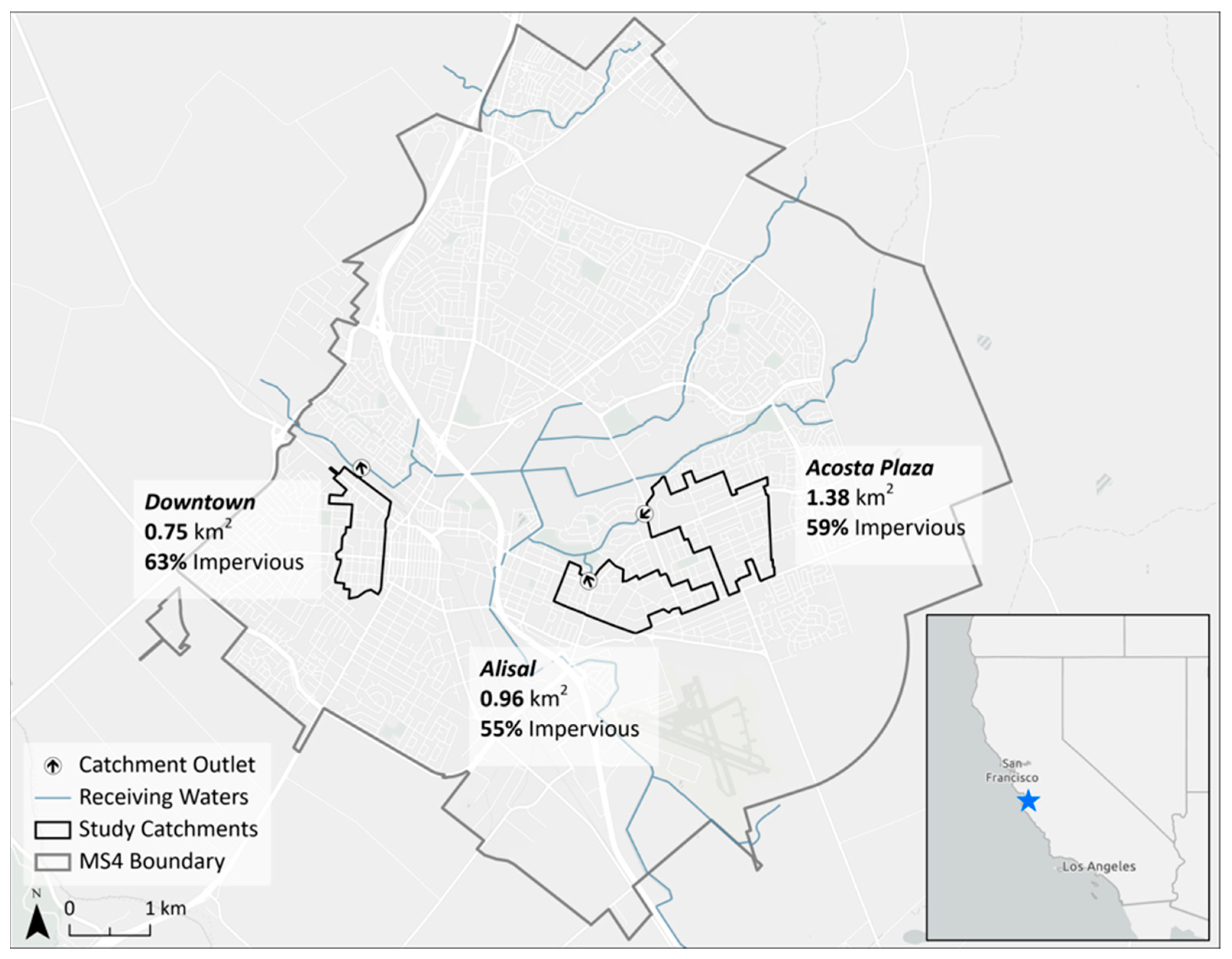

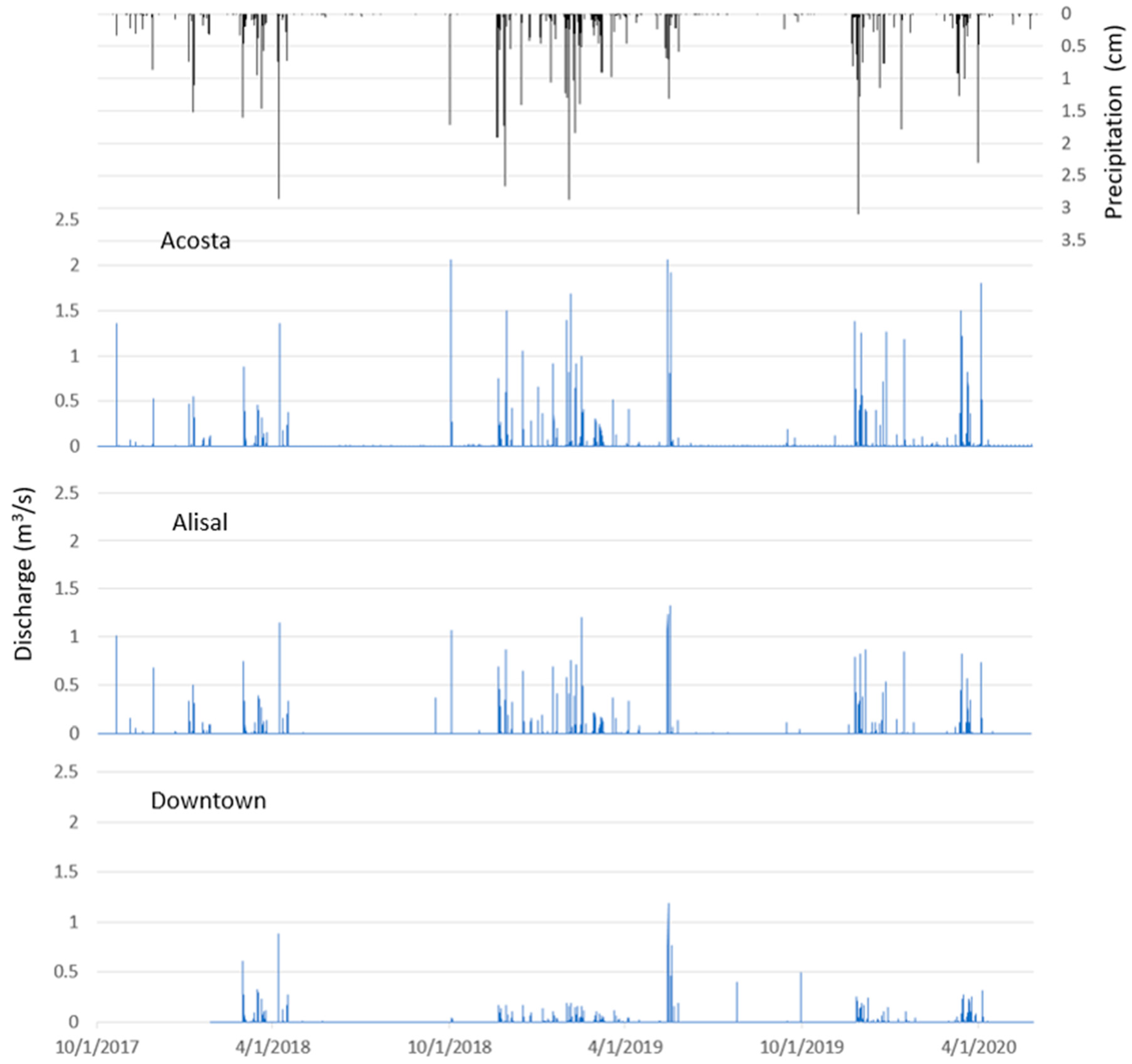
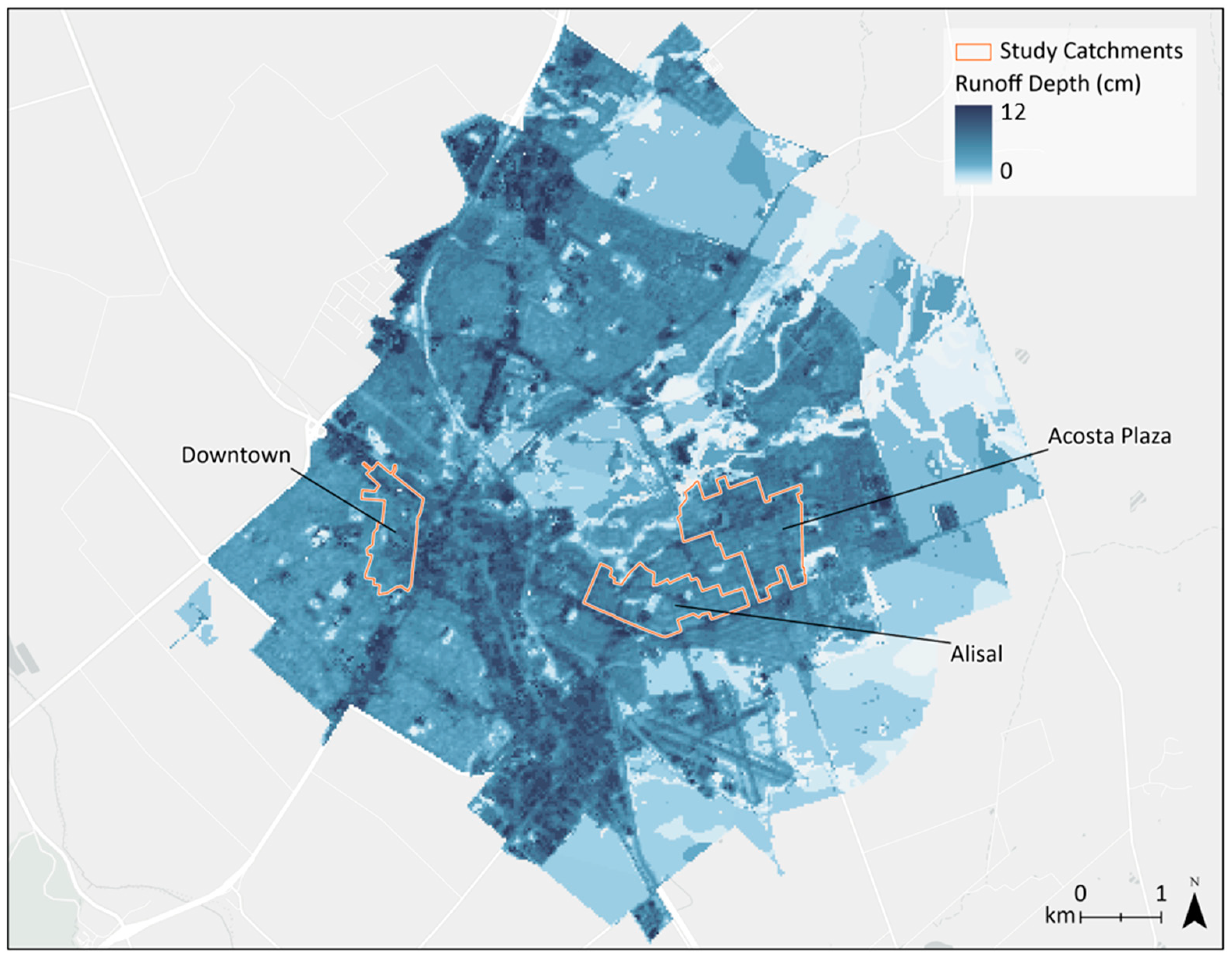

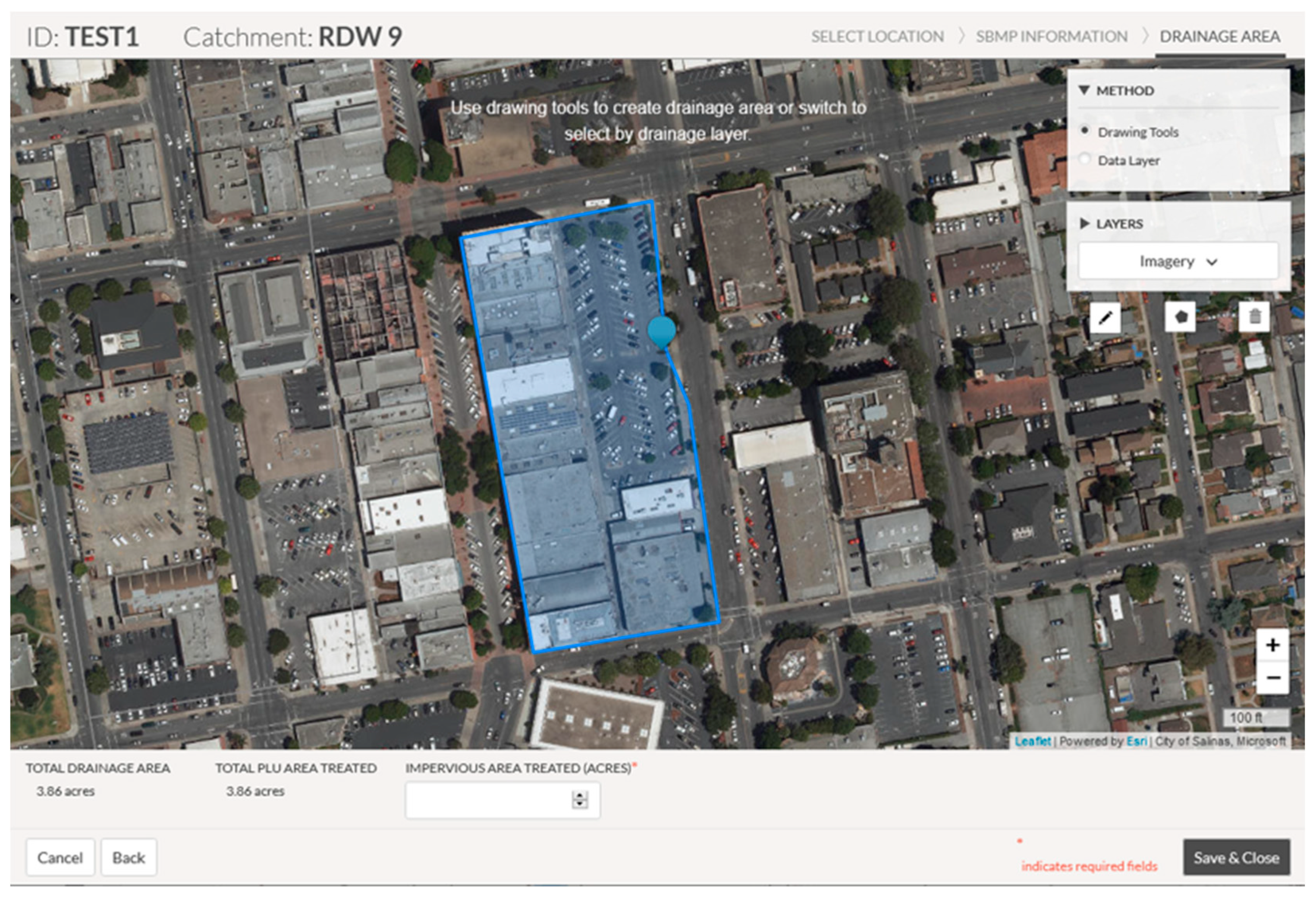
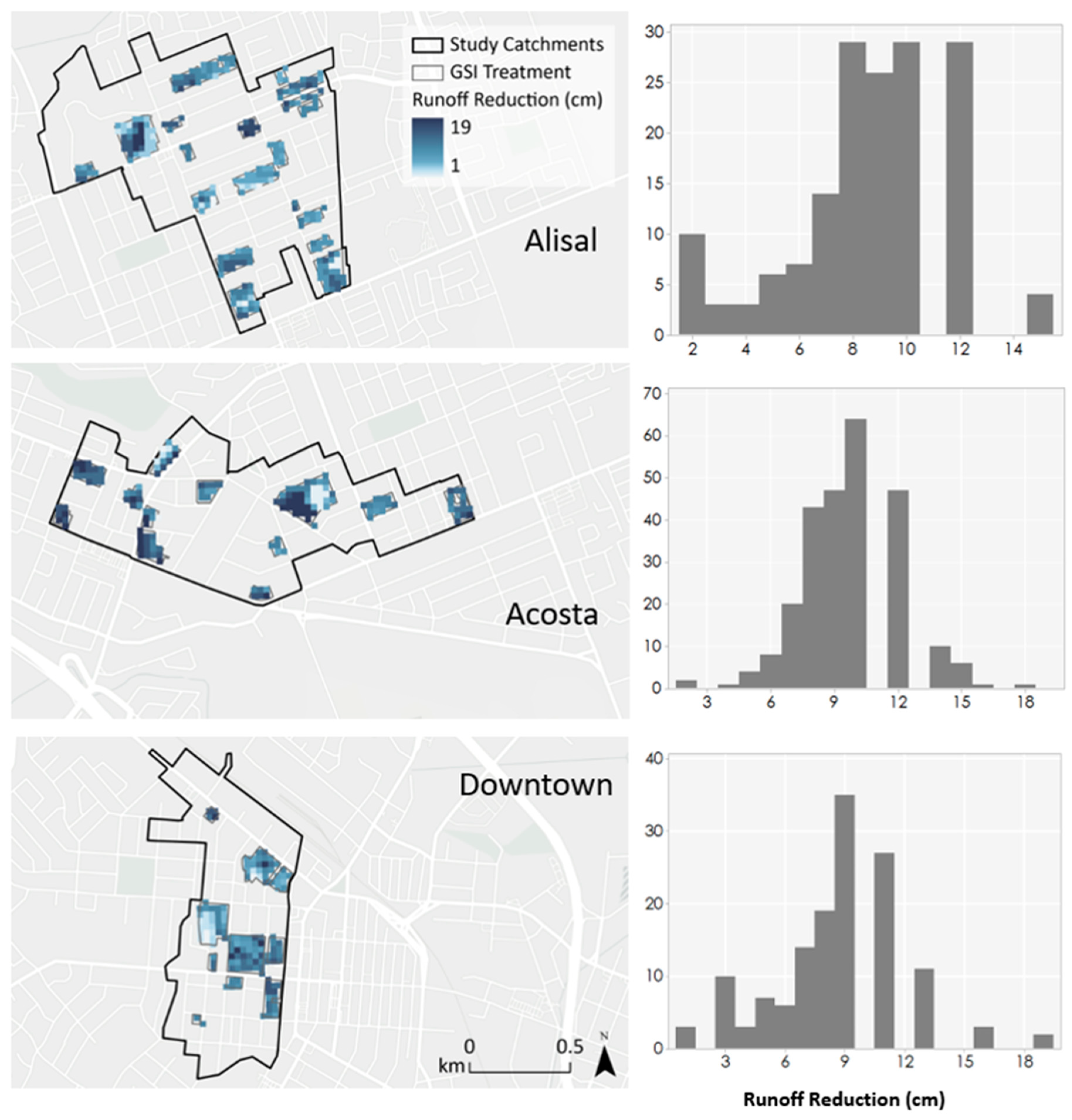
| Soil Type | A | B | C | D |
|---|---|---|---|---|
| Starting Curve Number | 68 | 79 | 86 | 89 |
| Acosta | Alisal | Downtown | ||||||
|---|---|---|---|---|---|---|---|---|
| Water Year | Number of Events > 1 cm | P (cm) | Q (ML/year) | Runoff Ratio | Q (ML/year) | Runoff Ratio | Q (ML/year) | RUNOFF RATIO |
| 2018 | 38 | 18.5 | 76.5 | 0.30 | 64.1 | 0.36 | 29.8 | 0.22 * |
| 2019 | 69 | 36.6 | 193.6 | 0.38 | 130.3 | 0.37 | 80.3 | 0.27 |
| 2020 | 42 | 21.7 | 156.3 | 0.52 | 106.0 | 0.51 | 55.6 | 0.34 |
| Observed (ML/year) | swTELR (ML/year) | Error | |
|---|---|---|---|
| Acosta | |||
| 2018 | 76.5 | 74 | −3.3% |
| 2019 | 193.6 | 202.1 | 4.4% |
| 2020 | 127.1 | 89.8 | −29.3% |
| Alisal | |||
| 2018 | 64.1 | 50.3 | −21.5% |
| 2019 | 130.3 | 137.5 | 5.5% |
| 2020 | 86.8 | 61 | −29.2% |
| Downtown | |||
| 2018 | 29.8 | 37 | 24.2% |
| 2019 | 80.3 | 101.8 | 26.8% |
| 2020 | 45.2 | 45 | −0.4% |
| Totals | 833.1 | 798.5 | 4.2% |
Publisher’s Note: MDPI stays neutral with regard to jurisdictional claims in published maps and institutional affiliations. |
© 2021 by the authors. Licensee MDPI, Basel, Switzerland. This article is an open access article distributed under the terms and conditions of the Creative Commons Attribution (CC BY) license (http://creativecommons.org/licenses/by/4.0/).
Share and Cite
Conley, G.; Beck, N.; Riihimaki, C.; McDonald, K.; Tanner, M. Assessing the Feasibility of a Cloud-Based, Spatially Distributed Modeling Approach for Tracking Green Stormwater Infrastructure Runoff Reductions. Water 2021, 13, 255. https://doi.org/10.3390/w13030255
Conley G, Beck N, Riihimaki C, McDonald K, Tanner M. Assessing the Feasibility of a Cloud-Based, Spatially Distributed Modeling Approach for Tracking Green Stormwater Infrastructure Runoff Reductions. Water. 2021; 13(3):255. https://doi.org/10.3390/w13030255
Chicago/Turabian StyleConley, Gary, Nicole Beck, Catherine Riihimaki, Krista McDonald, and Michelle Tanner. 2021. "Assessing the Feasibility of a Cloud-Based, Spatially Distributed Modeling Approach for Tracking Green Stormwater Infrastructure Runoff Reductions" Water 13, no. 3: 255. https://doi.org/10.3390/w13030255





